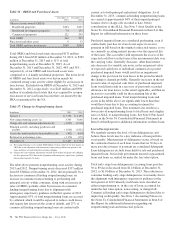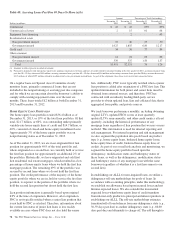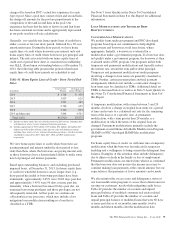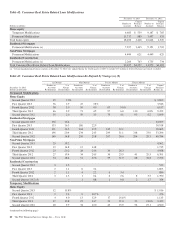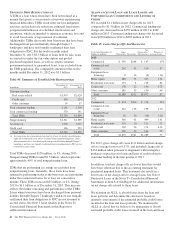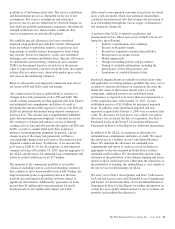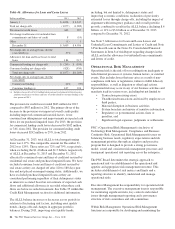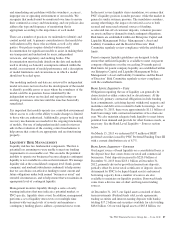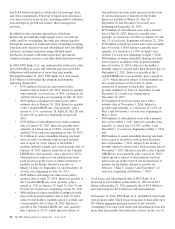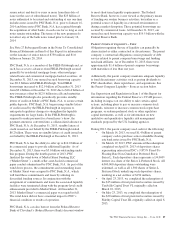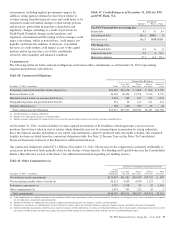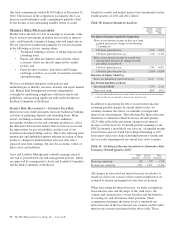PNC Bank 2013 Annual Report Download - page 101
Download and view the complete annual report
Please find page 101 of the 2013 PNC Bank annual report below. You can navigate through the pages in the report by either clicking on the pages listed below, or by using the keyword search tool below to find specific information within the annual report.portfolio as of the balance sheet date. The reserve calculation
and determination process is dependent on the use of key
assumptions. Key reserve assumptions and estimation
processes react to and are influenced by observed changes in
loan and lease portfolio performance experience, the financial
strength of the borrower, and economic conditions. Key
reserve assumptions are periodically updated.
We establish specific allowances for loans considered
impaired using methods prescribed by GAAP. All impaired
loans are subject to individual analysis, except leases and
large groups of smaller-balance homogeneous loans which
may include, but are not limited to, credit card, residential
mortgage and consumer installment loans. Specific allowances
for individual loans (including commercial and consumer
TDRs) are determined based on an analysis of the present
value of expected future cash flows from the loans discounted
at their effective interest rate, observable market price or the
fair value of the underlying collateral.
Reserves allocated to non-impaired commercial loan classes
are based on PD and LGD credit risk ratings.
Our commercial pool reserve methodology is sensitive to
changes in key risk parameters such as PD and LGD. The
results of these parameters are then applied to the loan balance
and unfunded loan commitments and letters of credit to
determine the amount of the respective reserves. Our PDs and
LGDs are primarily determined using internal commercial
loan loss data. This internal data is supplemented with third-
party data and management judgment, as deemed necessary.
We continue to evaluate and enhance our use of internal
commercial loss data and will periodically update our PDs and
LGDs, as well as consider third-party data, regulatory
guidance and management judgment. In general, a given
change in any of the major risk parameters will have a
corresponding change in the pool reserve allocations for non-
impaired commercial loans. To illustrate, if we increase the
pool reserve LGD by 5% for all categories of non-impaired
commercial loans at December 31, 2013, then the aggregate of
the ALLL and allowance for unfunded loan commitments and
letters of credit would increase by $73 million.
The majority of the commercial portfolio is secured by
collateral, including loans to asset-based lending customers
that continue to show demonstrably lower LGD. Further, the
large investment grade or equivalent portion of the loan
portfolio has performed well and has not been subject to
significant deterioration. Additionally, guarantees on loans
greater than $1 million and owner guarantees for small
business loans do not significantly impact our ALLL.
Allocations to non-impaired consumer loan classes are based
upon a roll-rate model which uses statistical relationships,
calculated from historical data that estimate the movement of
loan outstandings through the various stages of delinquency
and ultimately charge-off.
A portion of the ALLL is related to qualitative and
measurement factors. These factors may include, but are not
limited to, the following:
• Industry concentrations and conditions,
• Recent credit quality trends,
• Recent loss experience in particular portfolios,
• Recent macro-economic factors,
• Model imprecision,
• Changes in lending policies and procedures,
• Timing of available information, including the
performance of first lien positions, and
• Limitations of available historical data.
Purchased impaired loans are initially recorded at fair value
and applicable accounting guidance prohibits the carry over or
creation of valuation allowances at acquisition. Because the
initial fair values of these loans already reflect a credit
component, additional reserves are established when
performance is expected to be worse than our expectations as
of the acquisition date. At December 31, 2013, we had
established reserves of $1.0 billion for purchased impaired
loans. In addition, loans (purchased impaired and non-
impaired) acquired after January 1, 2009 were recorded at fair
value.No allowance for loan losses was carried over and no
allowance was created at the date of acquisition. See Note 6
Purchased Loans in the Notes To Consolidated Financial
Statements in Item 8 of this Report for additional information.
In addition to the ALLL, we maintain an allowance for
unfunded loan commitments and letters of credit. We report
this allowance as a liability on our Consolidated Balance
Sheet. We maintain the allowance for unfunded loan
commitments and letters of credit at a level we believe is
appropriate to absorb estimated probable losses on these
unfunded credit facilities. We determine this amount using
estimates of the probability of the ultimate funding and losses
related to those credit exposures. Other than the estimation of
the probability of funding, this methodology is very similar to
the one we use for determining our ALLL.
We refer you to Note 5 Asset Quality and Note 7 Allowances
for Loan and Lease Losses and Unfunded Loan Commitments
and Letters of Credit in the Notes To Consolidated Financial
Statements in Item 8 of this Report for further information on
certain key asset quality indicators that we use to evaluate our
portfolio and establish the allowances.
The PNC Financial Services Group, Inc. – Form 10-K 83





